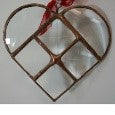
Using a Soldering Iron Temperature Controller
By Janet Parkhurst
As you become more skilled at soldering you may find that the number you have been setting you temperature control on no longer works the same. Things that affect the...
Read more$20 Flat Rate Shipping in the Contiguous U.S.

By Janet Parkhurst
As you become more skilled at soldering you may find that the number you have been setting you temperature control on no longer works the same. Things that affect the...
Read more
By Janet Parkhurst
In addition to there being different types of glass which we talked about in Know Your Glass (part 1) there are also different glass manufacturers. The manufacturers that we stock...
Read more
By Janet Parkhurst
We often see people just standing in front of our foil display looking overwhelmed! Here is a picture of our display just so you can see how overwhelming it is! ...
Read more
By Janet Parkhurst
Valentines Day is Coming To make the heart shown, use four 1x1" bevels and 2-2" half circles. You can also make it large by using 4- 1 1/2x 1 1/2...
Read more
By Janet Parkhurst
DICHROIC GLASS MOST INFO FROM HOWARD SANDBERG OF COATINGS BY SANDBERG Dichroic glass is one of the most beautiful things SGE carries and it has been one of the most...
Read more
By Janet Parkhurst
The basic thing to remember here is that Lead Came stretches. That really is the base fact in deciding when to use what. Use Foil: 1. Lamp Shades should always...
Read more
By Janet Parkhurst
Olympia with award made from SGE glass. This is, of course, Olympia Snow in 2012 getting an award from the State Chamber of Commerce. For many years, the State Chamber...
Read more
By Janet Parkhurst
I just went to the retail display where we keep pliers. There were 7 different ones. So many pliers—so many uses! Or just a little difference, like the width of the...
Read more
By Janet Parkhurst
Plugging a soldering iron into a rheostat (or temperature controller) does NOT reduce the temperature. It reduces the amount of electricity coming in but doesn't change the temperature the iron...
Read more
By Janet Parkhurst
The tough economy of 2011 and 2012 caused some glass manufacturing to cease. The GNA (German New Antique) factory has now been closed for some time. At first it was...
Read more
By Janet Parkhurst
Intermediate / Advanced How To: Frame Stained Glass Panels using Zinc Came "Came" is a channel made from a variety of metals and is available in various shapes. The two...
Read more
By Janet Parkhurst
(example is from C Rhodes Glass Art on Esty) Don' you love how your piece looks when it is foiled before it is soldered? That shiny copper foil just sparkles. Why,...
Read more
By Janet Parkhurst
Mary Harris is an artist from Wisconsin. She has a studio called Harris Art Glass. Mary came to my attention once before when she was winner in the Gallery of...
Read more